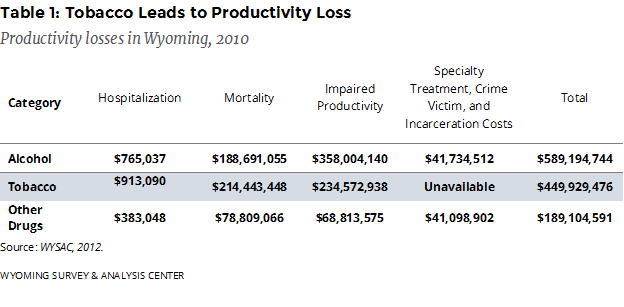Summary
The health and economic costs of smoking in Wyoming are substantial. The Wyoming Tobacco Prevention and Control Program (TPCP) shares four goals with the federal tobacco prevention and control program to reduce these costs: (a) reduce youth initiation of tobacco use (Centers for Disease Control and Prevention [CDC], 2014b), (b) eliminate exposure to secondhand smoke (CDC, 2017), (c) increase tobacco cessation attempts and successes (CDC, 2015b), and (d) eliminate tobacco-related disparities (CDC 2014b; 2015b; 2017).
The U.S. Surgeon General has concluded that smoking is harmful to nearly every organ in the body, causes disease, and worsens existing illnesses. According to the U.S. Surgeon General, 19 disease categories are causally associated with smoking (U.S. Department of Health and Human Services [USDHHS], 2014).
Approximately 800 Wyoming adults die every year from smoking-attributable causes, not including deaths attributable to exposure to secondhand smoke. Additionally, more than 12,000 Wyoming youth currently under the age of 18 will die prematurely from cigarette smoking (CDC, 2014a).
Considerable costs also arise from exposure to secondhand smoke (USDHHS, 2006), property losses from smoking-related fires (Hall, 2013), lower productivity of smokers (WYSAC, 2012), and additional cleaning and maintenance expenditures (Javitz, Zbikowski, Swan, & Jack, 2006).
Smoking-Attributable Loss of Life
Each year, 480,000 people in the United States die prematurely from smoking or from exposure to secondhand smoke (USDHHS, 2015). Tobacco use causes one in five deaths, more than the number of deaths attributable to alcohol, car crashes, suicides, AIDS, homicides, and illegal drugs combined (CDC, 2015a). These deaths come from such causes as
- Cancer, including cancers of the lungs, kidney, stomach, cervix, and pancreas;
- Cardiovascular and metabolic coronary heart disease;
- Cerebrovascular disease;
- Diabetes mellitus;
- Pneumonia;
- Pulmonary diseases; and
- Tuberculosis.
The following estimates of the impacts of smoking on health in Wyoming do not include the effects of secondhand smoke or fires, so they underestimate the true costs of smoking. Still, they provide useful estimates for smoking-related sickness and death.
- Each year, an estimated 800 Wyoming adults die prematurely from smoking-attributable illnesses such as cardiovascular disease, respiratory diseases, and cancers (primarily of the respiratory system; CDC, 2014a).
- If recent smoking trends continue, more than 12,000 Wyoming youth currently under the age of 18 are projected to die prematurely from cigarette smoking (CDC, 2014a).
Smoking also imposes substantial human costs in the United States:
- Between 1997 and 2006, on average, adult smokers died more than 10 years earlier than nonsmokers (Jha et al., 2013).
- Between 1965 and 2014, more than 20 million people died prematurely because of smoking and exposure to secondhand smoke (USDHHS, 2014).
Health Consequences of Exposure to Tobacco Smoke
The harmful health impacts of smoking are not limited to smokers: The U.S. Surgeon General stated, ¡§Exposure of adults to secondhand smoke has immediate adverse effects on the cardiovascular system and causes coronary heart disease and lung cancer¡¨ (USDHHS, 2006, p. 9), the effects of which have been estimated to cost the United States upwards of $13 billion annually (USDHHS, 2006, 2010). According to the Surgeon General, there is no risk-free level of exposure to tobacco smoke (USDHHS, 2010). Each year between 2005 and 2009, over 41,000 deaths in the United States were attributable to secondhand smoke, including almost 34,000 deaths from coronary heart disease and 7,300 deaths from lung cancer (USDHHS, 2014).
Smoking-Attributable Fires
In 2014 in the United States, smoking materials caused 17,200 home structure fires (5% of all home fires; National Fire Protection Association, 2017). These fires caused
- 570 deaths (21% of home fire deaths),
- 1,140 injuries (10% of home fire injuries), and
- $426 million in direct property damage (6% of damage from home fires).
Fires caused by smoking materials kill people around smokers. People who were not smoking (e.g., neighbors, visitors, and family members) or who were not involved with the smoking materials that started the fire comprised one fourth of the deaths from smoking-caused fires in 2011. To help reduce these losses, all 50 states have passed legislation requiring cigarette manufacturers to produce only cigarettes that are less likely to continue burning if left unattended (Hall, 2013).
Cleaning and Maintenance Costs
In 2006, Javitz et al. estimated that cigarette smoke added $728 per 1,000 square feet to the cleaning and maintenance costs of office space and $305 per 1,000 square feet to the cleaning and maintenance costs of industrial space relative to a smokefree workplace. Each smoker increased the cost of building ventilation by $84.
When considering aggregate costs and productivity impacts, Berman, Crane, Seiber, and Munur (2014) estimated that, on average, a U.S. smoker costs $5,816 more annually than a nonsmoker to employ. Of this cost, Berman et al. estimated that $3,077 is for smoking breaks, $2,056 is for excess healthcare costs, $517 is for excess missed work, and $462 is for working less productively while sick, with a savings of $296 for pension benefits resulting from premature death.
Lost Productivity

WYSAC (2012) compared the lost productivity costs of alcohol, tobacco, and other drug abuse in Wyoming. Table 1 presents a summary of the estimated productivity losses by substance. However, some data were not available at the state level, and WYSAC did not include less direct costs such as pain and suffering or the value of leisure or volunteer time. Therefore, as with medical care costs, all costs listed in Table 1 are underestimates of the true costs. Total productivity value includes cash wage/salary earnings, employer-provided insurance and retirement benefits, legally required employer costs, and household productivity. Tobacco was the costliest of the drugs with regards to productivity lost due to hospitalization and death. For impaired productivity (including lowered performance while at work and missing work), tobacco use was the second-costliest of these three classes of substance.
Wyoming Healthcare Costs of Tobacco
Annual smoking-attributable expenditures in Wyoming increased from $193.9 million in 2005 to $257.7 million in 2009, about a 33% increase. Most of this increase came from an increase in hospital expenditures; the increases in ambulatory, nursing home, prescription drugs, and other expenditures (including home care, medical equipment, and other professional services) were smaller (Smoking Attributable Mortality, Morbidity, and Economic Costs [SAMMEC]—Smoking Attributable Expenditures [SAE], 2017).
References
Berman, M., Crane, R., Seiber, E., Munur, M. (2014). Estimating the cost of a smoking employee. Tobacco Control, 23(5), 428–433. Retrieved March 30, 2016. doi: 10.1136/ tobaccocontrol-2012-050888
Centers for Disease Control and Prevention. (2014a). Best practices for comprehensive tobacco control programs – 2014. Atlanta, GA: U.S. Department of Health and Human Services, Centers for Disease Control and Prevention, National Center for Chronic Disease Prevention and Health Promotion, Office on Smoking and Health.
Centers for Disease Control and Prevention. (2014b). Preventing initiation of tobacco use: Outcome indicators for comprehensive tobacco control programs–2014. Atlanta, GA: Centers for Disease Control and Prevention, National Center for Chronic Disease Prevention and Health Promotion, Office on Smoking and Health.
Centers for Disease Control and Prevention. (2015a). Health effects of cigarette smoking. Retrieved March 30, 2016, from http://www.cdc.gov/tobacco/data_statistics/fact_sheets /health_effects/effects_cig_smoking/#definition
Centers for Disease Control and Prevention. (2015b). Promoting quitting among adults and young people: Outcome indicators for comprehensive tobacco control programs—2015. Atlanta, GA: Centers for Disease Control and Prevention, National Center for Chronic Disease Prevention and Health Promotion, Office on Smoking and Health.
Centers for Disease Control and Prevention. (2017). Eliminating exposure to secondhand smoke: Outcome indicators for comprehensive tobacco control programs–2017. Atlanta, GA: Centers for Disease Control and Prevention, National Center for Chronic Disease Prevention and Health Promotion, Office on Smoking and Health.
Hall, J., Jr. (2013). The smoking-material fire problem. National Fire Protection Association, Fire Analysis and Research Division. Retrieved on August 1, 2014, from http://www.nfpa.org /research/reports-and-statistics/fire-causes/smoking-materials
Javitz, H., Zbikowski, S., Swan, G. & Jack, L. (2006). Financial burden of tobacco use: An employer’s perspective. Clinics in Occupational and Environmental Medicine, 5, 9–29. doi: 10.1016/j.coem.2005.10.007
Jha, P., Ramasundarahettige, M., Landsman, V., Rostron, B., Thun, M., Anderson, R. N., McAfee, T., Peto, R. (2013). 21st-century hazards of smoking and benefits of cessation the United States. Massachusetts Medical Society, the New England Journal of Medicine, 368, 341-50. doi: 10.1056/NEJMsa1211128
National Fire Protection Association. (2017). Public education: Smoking. Retrieved December 14, 2017, from http://www.nfpa.org/public-education/by-topic/top-causes-of-fire/smoking
Smoking-Attributable Mortality, Morbidity, and Economic Costs (SAMMEC)—Smoking Attributable Expenditures (SAE) [Interactive Data Base 2005-2009]. (2017). Atlanta, GA: Centers for Disease Control and Prevention. Retrieved January 4, 2018, from https://chronicdata.cdc.gov/Health-Consequences-and-Costs/Smoking-Attributable-Mortality-Morbidity-and-Econo/ezab-8sq5
U.S. Department of Health and Human Services. (2006). The health consequences of involuntary exposure to tobacco smoke: A report of the Surgeon General. Retrieved January 11, 2013, from http://www.surgeongeneral.gov/library/reports/secondhandsmoke/index.html
U.S. Department of Health and Human Services. (2010). 2010 Surgeon General’s report—How tobacco smoke causes disease: The biology and behavioral basis for smoking-attributable disease. Retrieved July 8, 2011, from http://www.cdc.gov/tobacco/data_statistics/sgr/2010 /index.htm
U.S. Department of Health and Human Services. (2014). The health consequences of smoking – 50 years of progress: A report of the Surgeon General. Retrieved April 28, 2016, from http://www.cdc.gov/tobacco/data_statistics/sgr/50th-anniversary/index.htm
U.S. Department of Health and Human Services. (2015). Promoting health and preventing disease and injury through workplace tobacco policies. Retrieved April 14, 2016, from http://www.cdc.gov/niosh/docs/2015-113/
WYSAC. (2012). Cost of substance abuse in Wyoming 2010, by N. M. Nelson, M. Kato, & H. Costello. (WYSAC Technical Report No. DER-1250). Laramie, WY: Wyoming Survey & Analysis Center, University of Wyoming.

